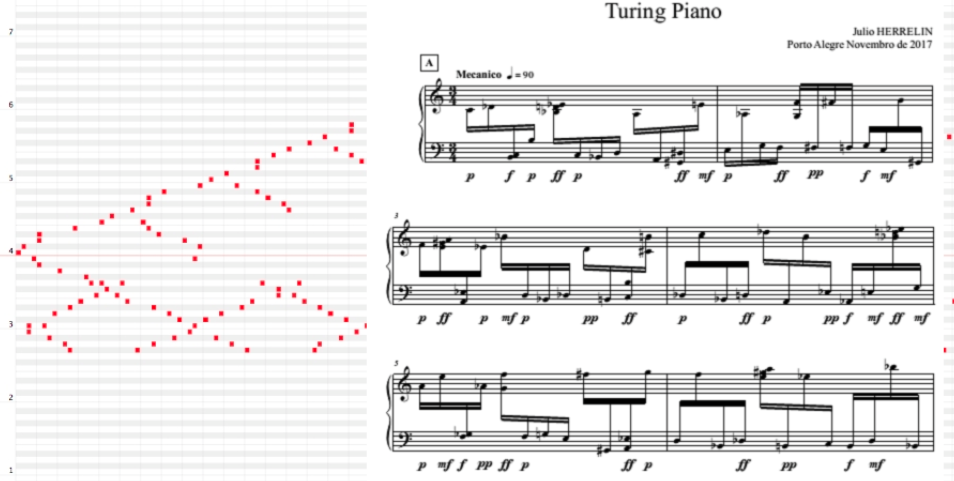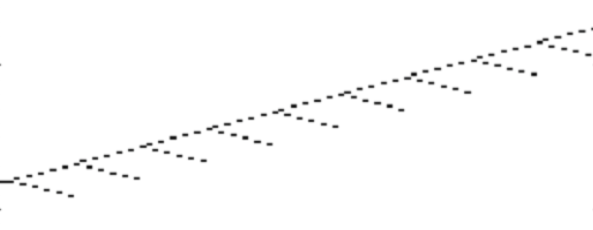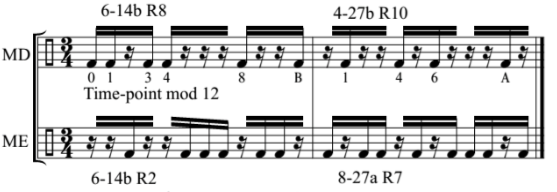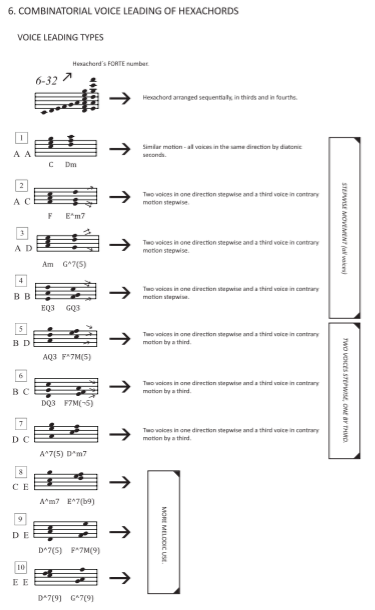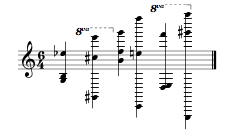-
Posts
839 -
Joined
-
Last visited
Content Type
Forums
Events
Store
Video Gallery
Everything posted by JulioHerrlein
-
Sometime ago, I was searching for a function that would be the exact opposite function of length-legato. Lenght-legato turns this: onto this: I wanted exactly the reverse: Changing this: to this: In the ocasion, Andre Meier came with this code below: Janusz, do you think a good idea to include a function like this in the library ? Or there is also something similar that I dont know ? I still need it in a easy way... Best, Julio (defun length-staccato (n alist) (let ((newlengths) (new-omn (omn-merge-ties (flatten alist))) (time-sign (get-time-signature alist))) (progn (setf newlengths (loop for i in (omn :length new-omn) when (> i 0) append (if (= n i) (list i) (list n (* -1 (abs (- i n))))) else collect i)) (if (omn-formp alist) (omn-to-time-signature (make-omn :length newlengths :pitch (omn :pitch new-omn) :velocity (omn :velocity new-omn) :articulation (omn :articulation new-omn)) time-sign) newlengths)))) (length-staccato 1/16 '(q -q q q)) (length-staccato 1/16 '(q e4 mp q tasto q -q q q)) (length-staccato 1/16 '((e. c4 eb4 fs4 a4 tie) (s a4 e. cs4 e4 g4 e bb4 tie) (e bb4 e. d4 f4 gs4 s b4)))
-

video Turing Piano (Julio Herrlein)
JulioHerrlein replied to JulioHerrlein's topic in Made In Opusmodus
Thank you, SB ! -
Thank You, SB !
- 10 replies
-
- rhythm
- set theory
-
(and 3 more)
Tagged with:
-
Thanks a lot, my friend ! Best, Julio
- 10 replies
-
- rhythm
- set theory
-
(and 3 more)
Tagged with:
-

video Turing Piano (Julio Herrlein)
JulioHerrlein replied to JulioHerrlein's topic in Made In Opusmodus
Nice to hear It from You, Loopyc ! Hope it can be inspiring ! Best, Julio added 0 minutes later Thank You, Janusz ! -
Thank You, Loopyc ! I' m trying to make this as practical as possible, applying the concepts in compositions and also for improvising. Best, Julio added 11 minutes later Thank You, Janusz !!!
- 10 replies
-
- rhythm
- set theory
-
(and 3 more)
Tagged with:
-
Dear Friends In my Doctoral Dissertation, I converted every FORTE number in a modulo 12 Rhythm via time-point-system. There is a complete catalog included (see the link below). It's in portuguese. After Janusz adjusted the Forte numbers to have the inversion, using "a" and "b" to differentiate the prime forms from the inversions, it was easy to convert using codes like this: (setf ch0 (time-point-system (pcs '5-11b :pitch)'s :start 0)) (setf ch1 (time-point-system (pcs '6-33 :pitch)'s :start 1)) (setf ch2 (time-point-system (pcs '7-11b :pitch)'s :start 2)) (setf ch3 (time-point-system (pcs '3-11b :pitch)'s :start 3)) (setf ch4 (time-point-system (pcs '3-11b :pitch)'s :start 0)) The dissertation (in portuguese) can be downloaded HERE: Das alturas ao ritmo : teoria dos conjuntos rítmicos como ferramenta composicional From pitches to rhythm: rhythmic set theory as a compositional tool. http://hdl.handle.net/10183/179457 Abstract This doctoral dissertation is divided into two parts: the first deals a rhythmic set theory, and the second contains the portfolio of compositions developed during this period of studies. This dissertation presents a system of rhythmic organization parallel to the musical set theory pitch class organization FORTE (1973), as well as an adaptation of the time-point-system (BABBITT, 1962). From the standpoint of the traditional set theory, and also from the diatonic set theory, this unified approach allows to estabilish a connecting tissue of basic aspects: from the harmony and chords symbols to the rhythmic organization. At one time, in a complete catalog, the families of pitch class sets and chord symbols are related to their respective rhythmic counterparts. The musical motivation for this research came from my interest in the swinging and groovy repetitive rhythms called timelines (TOUSSAINT, 2013), commonly used in popular music. These dancing timelines have properties similar to those of the diatonic sets, and for this reason, this dissertation presents some properties of the diatonic pitch class sets, drawing a parallel with their rhythmic counterparts. These relationships also appear in the portfolio of compositions, characterizing some procedures used. The portfolio of compositions, which includes a composition for symphony orchestra, is presented form the standpoint of a duality between transparency and opacity. This duality address the essential differences in the audibility of the results from various composition techniques. This study of Rhythmic Set Theory will serve as an analytical approach of my compositional output in popular music, with a systematic way to understant and to extrapolate some aspects already used in my practice as composer and improviser. Here is an analysis of a Wayne Krantz improvisation, using the rhythmic set theory system. Hope you enjoy !! Best, Julio
- 10 replies
-
- rhythm
- set theory
-
(and 3 more)
Tagged with:
-
Dear Friends, I'd like to share a composition all made in Opusmodus. The composition is part of the Portfolio of my Doctoral Dissertation. I'd like to thank you so much, Opusmodus and the support of you here in this forum was amazing !! Love you all !! TURING PIANO (Julio Herrlein) Here is the commented code for the First Section: ;;;PART A ;PITCHES – The pitch structure are based on "chevron-like" patterns. This can be related to some Xenakis ideas: the arborescences, the music as a plot idea. (setf patpit (integer-to-pitch (gen-integer-step 0 68 '(1 -2 3 -4 5 -6 7 -8 9 -10 11)))) (setf patpit2 (integer-to-pitch (gen-integer-step 0 68 '(11 -10 9 -8 7 -6 5 -4 3 -2 1)))) ;;; This interval pattern leads to an infinite ascending movement, like the picture below: ;;; After that, I decided to restrict the ambitus of the pattern, otherwise it goes ascending forever. I did the restriction thinking in the hands of the pianist, in a way to not collide or crossing the hands. ;;;After the ambitus restriction, the next step was find some partitions to make some chords for the piece, so each hand have a diferent partition of the chevron-like pattern, like below (setf pitpartition (ambitus '(g3 c6)(chordize-list (gen-divide '(1 1 1 3 1 1 1 2) patpit)))) (setf pitpartition2 (ambitus '(g1 g3)(chordize-list (gen-divide '(2 1 1 1 1 2 1 1 1 1 1 1 1 1) patpit2)))) ;;; Next, i decided on the Rhythms to use. The rhythms are complementary, i.e., each hand plays on the silence of the other, using the following pattern: DIGRESSION: The FORTE NUMBERS are part of my dissertation that makes the conversion of the entire Forte sets onto Rhythms modulo 12. The dissertation (in portuguese) can be downloaded HERE: Das alturas ao ritmo : teoria dos conjuntos rítmicos como ferramenta composicional From pitches to rhythm: rhythmic set theory as a compositional tool. http://hdl.handle.net/10183/179457 Abstract This doctoral dissertation is divided into two parts: the first deals a rhythmic set theory, and the second contains the portfolio of compositions developed during this period of studies. This dissertation presents a system of rhythmic organization parallel to the musical set theory pitch class organization FORTE (1973), as well as an adaptation of the time-point-system (BABBITT, 1962). From the standpoint of the traditional set theory, and also from the diatonic set theory, this unified approach allows to estabilish a connecting tissue of basic aspects: from the harmony and chords symbols to the rhythmic organization. At one time, in a complete catalog, the families of pitch class sets and chord symbols are related to their respective rhythmic counterparts. The musical motivation for this research came from my interest in the swinging and groovy repetitive rhythms called timelines (TOUSSAINT, 2013), commonly used in popular music. These dancing timelines have properties similar to those of the diatonic sets, and for this reason, this dissertation presents some properties of the diatonic pitch class sets, drawing a parallel with their rhythmic counterparts. These relationships also appear in the portfolio of compositions, characterizing some procedures used. The portfolio of compositions, which includes a composition for symphony orchestra, is presented form the standpoint of a duality between transparency and opacity. This duality address the essential differences in the audibility of the results from various composition techniques. This study of Rhythmic Set Theory will serve as an analytical approach of my compositional output in popular music, with a systematic way to understant and to extrapolate some aspects already used in my practice as composer and improviser. Here is the rhythm used in Turing Piano (with Forte numbers and rotations) (setf ritmo1 (gen-repeat 10 '(s s -s s s -s -s -s s -s -s s -s s -s -s s -s s -s -s -s s -s))) (setf ritmo1b (length-invert ritmo1 :omn t)) ; DINAMICS: Following the parametric stuff, I decided to set the dynamics, according to the harmonic density, i.e. the more notes, the more louder. (setf din1 (span pitpartition '(p p p ff p mf pp ff))) (setf din2 (span pitpartition2 '(f p p p p ff p p ff pp pp f mf mf))) ;ASSEMBLING of the materials (setf lhmat1 (make-omn :length ritmo1 :pitch (pitch-transpose 4 pitpartition) :velocity din1)) (setf rhmat1 (make-omn :length ritmo1b :pitch (pitch-transpose 4 pitpartition2) :velocity din2)) ;MONTAGE of music blocks (assemblage) (setf pianoassemblerh (assemble-seq lhmat1)) (setf pianoassemblelh (assemble-seq rhmat1)) ;;;SCORE- Layout (def-score Miniatura-pno1 (:key-signature 'atonal :time-signature '(3 4) :tempo 85 :octave-shift '(c2 c6) :layout (grand-layout 'pno :all-accidentals 'all)) (pno :omn (merge-voices lhmat1 rhmat1) :channel 1 :sound 'gm :program 0) ) COMPLETE VIDEO
-
More praises and likes to you, guys !! Best ! Julio
-
I love your loops, André ! Best, Julio
-
tonality-map ? (setf seq1 '(c4 cs4 d4 ds4 e4 f4 fs4 g4 gs4 a4 as4 b4)) (tonality-map '(major) seq1) => (c4 c4 d4 d4 e4 f4 f4 g4 a4 a4 a4 b4)
-
Thanks, Stephane !
-
For example: This syntax (expand-chord '(c4 69)) will give you a C(6,9) chord. Evaluate the expression via CMD+1 to get the snippet in notation. added 5 minutes later Maybe Janusz can help me here: When I evaluate this: (chord-inversion 1 (expand-chord '(c4 69))) I get this e4g4a4d5c6 However, when I try to get the snippet, via CMD+1, I get an error: > Error: The value e4g4a4d5c6 is not of the expected type list. > While executing: parse-chord-form-from-stream, in process Listener-1(6). > Type cmd-. to abort, cmd-\ for a list of available restarts. > Type :? for other options.
-

Changing MIDI channels with articulations
JulioHerrlein replied to torstenanders's topic in Support & Troubleshooting
Me too !!! Thanks ! -
Great idea, Torsten Very pedagogic example too. Thanks a lot. Im studying a lot of diatonic set Theory now, so I'm interested on mod 12 and mod 7 operations. The problem with the diatonic stuff is that is, in the lingo of Robert Morris, a pitch space with a irregular but periodic division. Best Julio
-
Thank you, Torsten. You are digging a lot into the realm of modelling tonality. I think that this is really something more interesting than brownian motions, stochastic stuff, because there are many constraints in the tonality and also idiomatisms. Models like the xenakian one are amazing but the are in the realm of math. I'd like to find something more idiomatic. Best, Julio
-
I'm thinking about the formal conditions of the diatonic transposition. It may seem trivial, but actually is much more difficult than it appears. I think that modelling tonality and diatonic stuff is far more difficult than the 12-tone operations. One of the things I think is that in diatonic transposition you need to inform more to the machine, a kind of axis point or map, because the transposition of each degree is going to be different. In the case of the diatonic set, the MyHill property assures that each diatonic distance will be in exactly 2 sizes. Seconds: major and minor; Thirds: major and minor; Fourths: perfect and augmented; Fifths: perfect and diminished and so on... The Morris pitch spaces are also part of the problem... Do you have any hint in relation to this intuitions to share ? Maybe the way that OM make this operations ? Best, Julio
-
Dear All, HAPPY 2018 !! With the new PCS organization in Opusmodus is possible to implement a concept of my book, called Combinatorial Voiceleading of Hexachords. From a Hexachord Set, is possible to find 10 different ways to combine the notes in the for of voice-leading sets. Each hexachord is divided in (3 + 3) way. This expression: (setf hexavl (mclist (chordize-list (integer-to-pitch (remove-duplicates (sort-asc (gen-divide 3 (flatten (permute (pcs '6-32))))) :test #'equal))))) Will result in this combination of the 6-32 hexachord, similar to the idea in the book. In the book, the material is organized in 70 pages of melodic and harmonic exercises. Here is a litte sample: CH_HERRLEIN.pdf The entire book: https://www.melbay.com/Products/Default.aspx?bookid=30042BCDEB Best ! Julio Herrlein
-
- combinatorial harmony
- voice-leading
-
(and 1 more)
Tagged with:
-
Thanks, Janusz !
-
Possible workaround: (remove-duplicates (sort-asc (combination 3 (pcs '6-1))) :test #'equal)
-
I need a function to filter the Permutations. For example: (gen-divide 2 (flatten (permute (pcs '4-1)))) Will result in: ((0 1) (2 3) (0 1) (3 2) (0 2) (1 3) (0 2) (3 1) (0 3) (1 2) (0 3) (2 1) (1 0) (2 3) (1 0) (3 2) (1 2) (0 3) (1 2) (3 0) (1 3) (0 2) (1 3) (2 0) (2 0) (1 3) (2 0) (3 1) (2 1) (0 3) (2 1) (3 0) (2 3) (0 1) (2 3) (1 0) (3 0) (1 2) (3 0) (2 1) (3 1) (0 2) (3 1) (2 0) (3 2) (0 1) (3 2) (1 0)) But I don't mind with the order, since I'll make chords out of it, so ((0 1) (2 3) or (0 1) (3 2) or (1 0) (2 3) will result in the same chord. How to filter the list onto a list where the order does not matter ? Best, Julio
-
Janusz suggested a different way for the expression: (setf voices 3) (setf chordstovl2 '(b3eb5g3 cs6e7gs3 b4f5g6 f7e5c2 d4f7e4 gs7e2a8)) (setf chordmelo (pitch-melodize chordstovl2)) (setf intervals (integer-to-interval (modus (pitch-to-midi chordmelo)))) (setf map (replace-map '((-11 1) (-10 2) (-9 3) (-8 4) (-7 5) (7 -5) (8 -4) (9 -3) (10 -2) (11 -1)) intervals)) (setf vlfinal (integer-to-pitch (modus (interval-to-pitch map :start (car chordmelo))))) (setf chordized (mclist (chordize-list (gen-divide voices vlfinal)))) (chord-closest-path (car chordized) chordized)
- 23 replies
-
- voice-leading
- parsimonious voice leading
-
(and 1 more)
Tagged with:
-
Parsimonious Voice Leading (again): attempts to provide an algorithm In a previous post I deleted, I was trying to find a good way to ensure the minimal parsimonious Voice-Leading (VL) between a sequence of chords. In this post I will try to explain my second attempt. Let's take a look at a sequence of chords, spreaded out almost in a random way, with no VL (setf chordstovl2 '(b3eb5g3 cs6e7gs3 b4f5g6 f7e5c2 d4f7e4 gs7e2a8) Let's specify and evaluate a variable for the number of voices used: (setf voices 3) Let's try to think the best way to connect this pitches with minimal movement. I will apply the following expression to ensure a better and less ambiguous result when applying the CHORD-CLOSEST-PATH function. Evaluate voices before (setf voices 3) Then (setf chordized (mclist (chordize-list (gen-divide voices (setf vlfinal (integer-to-pitch (modus (interval-to-pitch (replace-map '((-11 1) (-10 2) (-9 3) (-8 4) (-7 5) (7 -5) (8 -4) (9 -3)(10 -2)(11 -1)) (integer-to-interval (modus (pitch-to-midi (setf chordmelo (pitch-melodize chordstovl2)))))) :start (car chordmelo))))))))) Please note the use of the replace-map function ensuring that no movement will be greater than a tritone away. This means that a movement like "C to G" (7 semitones) will be convertet in a G to C (5 semitones). This ensure a modulo 12 (octave constraint) reduction of all the material and also a constraint in terms of the size of the movements that will not exceed 6 semitones. Finally, I will apply the CHORD-CLOSEST-PATH function (chord-closest-path (car chordized) (chordize-list (gen-divide voices vlfinal))) Hope it help some VL efforts. Best, Julio Herrlein
- 23 replies
-
- voice-leading
- parsimonious voice leading
-
(and 1 more)
Tagged with:
-
Great !!! New Year Version!! BEst ! Julio





